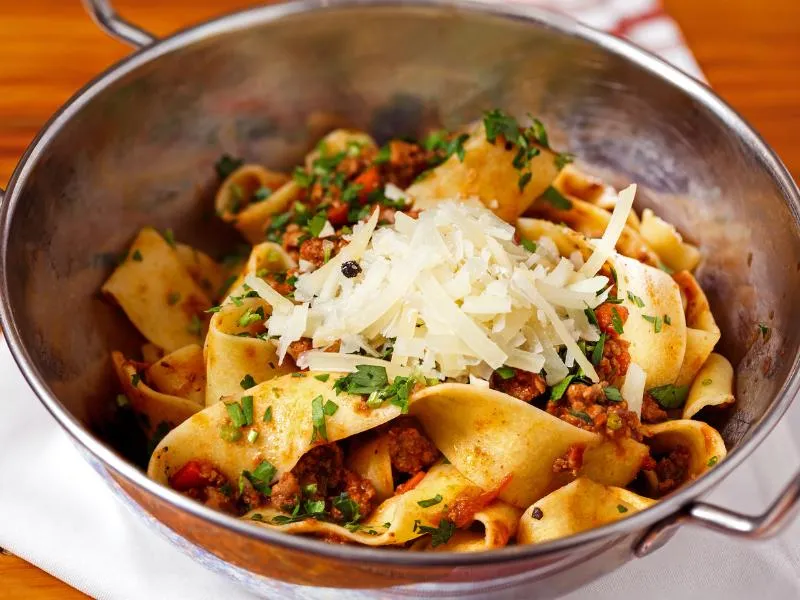Pappardelle al Cinghiale
Wide ribbon pasta served with a rich, slow-cooked wild boar ragù, infused with herbs and red wine.
👉 View Authentic Recipe 👈
About This Dish
Pappardelle al Cinghiale is a cornerstone of Tuscan cuisine, originating in the forested regions where wild boar (cinghiale) hunting has been practiced since Etruscan times. This hearty dish combines wide, flat pappardelle pasta with a slow-cooked ragù made from wild boar meat, typically marinated in red wine with herbs and juniper berries to tame the strong gamey flavor.
The dish exemplifies the rustic, hunter-style cooking (cucina di cacciagione) that defines inland Tuscan gastronomy, particularly in areas like Maremma, Chianti, and the hills of Siena. Traditionally prepared during hunting season in fall and winter, it represents the Tuscan philosophy of transforming humble, local ingredients into extraordinary meals.
While recipes vary from household to household, authentic versions always incorporate a soffritto base (finely chopped onions, carrots, and celery), robust Tuscan herbs like rosemary and sage, and often chocolate or cocoa powder to add depth and counterbalance the gamey notes of the meat. The sauce must simmer for hours, allowing the wild boar to become incredibly tender and the flavors to develop fully.
🧑🍳 Analyzed by CucinaBot
Why This Dish Works
The culinary success of Pappardelle al Cinghiale relies on several key principles: the slow braising process breaks down the tough collagen in wild boar into rich gelatin, creating a velvety mouthfeel; the acidic components (wine and tomatoes) help tenderize the meat while balancing the gamey flavor; and the wide pappardelle pasta provides the perfect vehicle for capturing the robust sauce, with its large surface area allowing for maximum flavor adhesion.
Key Success Factors
- Proper Marination: Wild boar requires 12-24 hours of marination in red wine with aromatic herbs to tenderize the meat and reduce gaminess
- Slow Cooking Time: A minimum 3-4 hour simmer is essential for developing depth of flavor and proper meat texture
- Pasta Width: Authentic pappardelle should be 2-3cm wide to stand up to the substantial sauce
- Sauce Consistency: The ragù should coat a spoon but not be too thick—wild boar releases less fat than domestic pork
Common Pitfalls
Many non-authentic recipes substitute regular pork for wild boar, losing the distinctive gamey flavor that defines this dish. Another common mistake is insufficient cooking time, resulting in tough meat and underdeveloped flavors. Some versions also omit the crucial marination step or add excessive tomato, creating a dish closer to standard bolognese than the traditional hunter-style ragù.
How to Judge Authenticity
When reviewing recipes, look for these markers of authenticity:
- Specifies wild boar meat (cinghiale) with marination in red wine and juniper
- Includes minimal tomato—just enough to add acidity, not to dominate
- Lists a cooking time of at least 3 hours for the ragù
- Incorporates herbs typical of Tuscan cuisine (rosemary, sage, bay leaf)
- Contains a small amount of dark chocolate or cocoa powder for depth